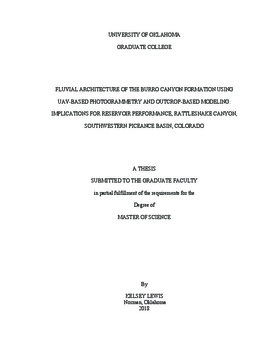| dc.description.abstract | The stratigraphic variability of fluvial architectural elements and their internal lithological and petrophysical heterogeneity influence static connectivity and fluid flow. To explore the impact of fluvial architecture and facies heterogeneity on reservoir performance, well-exposed outcrops of the Cretaceous Burro Canyon Formation in Rattlesnake Canyon, Colorado, are evaluated. Analysis of the sedimentology and channel architecture of the Burro Canyon Formation provides insights into the low net- to-gross ratio, sandy, braided-fluvial style. The Burro Canyon Formation represents a South Saskatchewan type, perennial, braided fluvial system. A single depositional sequence is present in Rattlesnake Canyon containing a series of stacked amalgamated and semi-amalgamated channel complexes, composed of four architectural elements: amalgamated channel complexes, amalgamated fluvial-bar deposits, isolated fluvial-bar deposits, and floodplain fines.
Stratigraphic measured sections, outcrop gamma-ray measurements, and UAV- based (Unmanned Aerial Vehicle-based) photogrammetry are used to constrain two- dimensional (2-D) and three-dimensional (3-D) static reservoir models of the fluvial deposits. Resulting breakthrough times (BTT) and sweep efficiency suggest subsurface performance is most effective perpendicular to paleoflow direction in amalgamated channel sequences. Perpendicular to paleoflow, BTT occurs 9% faster than parallel to the paleoflow and sweep efficiency is, on average, 16% greater. Sweep efficiency and BTT are greater perpendicular to paleoflow due to greater sandstone connectivity in this orientation. Variability of preserved channels and lateral pitchouts results in lower recovery efficiency. Reservoir heterogeneity can account for 50% variation in BTT and
lower recovery efficiency by 5% through low petrophysical zones that trap fluids. Cemented conglomeratic facies decrease recovery efficiency by 15%, but increase sweep efficiency and BTT by 28% and 32%, respectively, creating fluid-flow barriers as conglomeratic facies fill basal scours in the Burro Canyon Formation. | en_US |
